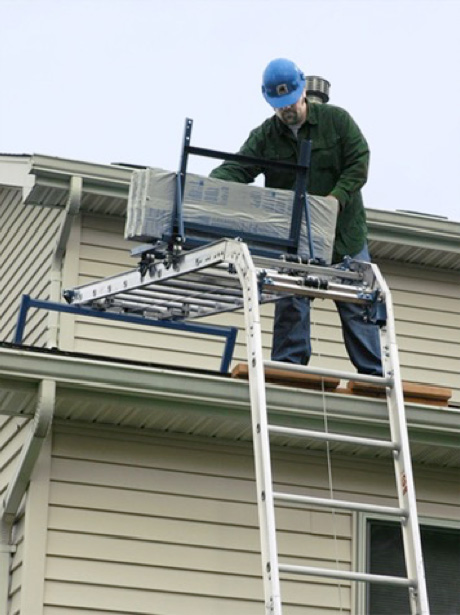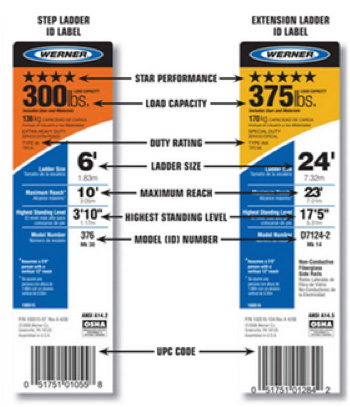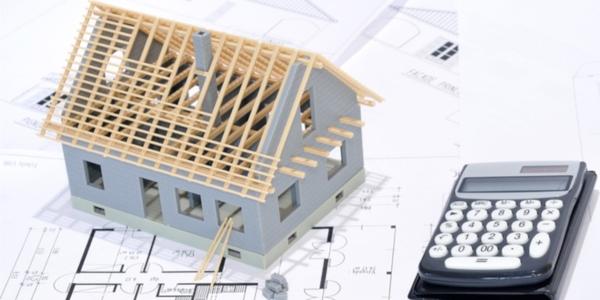How to choose the right roof ladder for the job

By IKO.
Choosing the correct ladder for your job will provide greater safety and quicker installation.
As a residential roofer, your tools are an important part of everyday life. When used properly and chosen carefully they can help keep you safe, make the job go more smoothly and allow your work to really shine.
Choosing a roofing ladder should be no different.
A good ladder can give you easy access to heights and support you as you work on awkward roof slopes (always combined with proper fall arrest measures, of course). The different variations of ladders available to choose from, plus the supporting accessories available, can make a world of difference between a long, laborious installation and a quick, efficient one.
With that in mind, read our tips below. Choose wisely by thinking about the houses and sites you work on and what obstacles a good ladder might help you overcome. There are a ton of neat – and helpful – features out there and some innovative add-ons that will make it seem like the world of ladders has been personalized just for you.
All about roofing ladders.
Ladders come in all different shapes and sizes and feature many different characteristics to make your job safer and easier.
So, before you begin your hunt, think about what you’ll use your ladder for, or what different combinations of ladders you may need to complete a job. Consider your daily tasks on the job site – do you need access to the roof, a means to scale the roof itself, or an elevated ladder beside the home that can double as a mini work station?
For instance, to install shingles, you will likely need a stepladder or extension ladder to get to the roof and then a roofing ladder affixed to the roof to complete the work. Be sure to always tie off your ladder using an anchor (or other stabilizer) to ensure it doesn’t slide sideways as you get onto the roof. We mention a few options further below in our “Stabilizers” section.
(Source: ProToolReviews.)
Ladder Style
Fixed
Fixed ladders are installed as a permanent or long-term fixture of a building or facility. Residential roofers for the most part won’t come across this style often in their work, because they are most often seen in commercial applications, when access to a roof is required year-round.
Mobile Self-Supporting
These are ladders that stand on their own, knowns as stepladders or A-Frame ladders. These come in a range of sizes and load rating – from your typical household ladder to more professional grade styles, which can handle heavier weights.
Non Self-Supporting
As the name suggests, a non self-supporting ladder is usually called a straight ladder or extension ladder and must lean up against something (i.e. a building) to be secure.
(Source: Roofing Contractor and American Ladder Institute.)
Residential roofers will most often use a combination of different ladders to install shingles or complete other roofing tasks. Roofers will usually use an extension ladder to gain access to the roof and a second extension ladder with wheels and hooks (to secure it to the ridge of the roof), to complete the work from the roof.
Roofing ladder
A roofing ladder is simply an extension ladder that has been securely attached to the ridge of a sloped roof to allow a roofer to work from an angle (though, no more than 75 degrees) on the roof.
To secure the extending roof ladder, a pair of roof hooks should be installed onto the ladder. These are often accompanied by rolling wheels that allow you to push the ladder up the height of the roof.
Never rest your ladder on the eavestrough or gutter of a roof as a sole means of support – this will not be able to hold the weight of workers and/or materials.
Though technically not a ladder, there is also a roof support system called a “crawl board” or “chicken ladder” that comprises a board that’s hooked onto the roof ridge with smaller boards nailed to it that act as foot holds, called cleats. The Occupational Health and Safety Association has detailed requirements for these boards, so be sure to familiarize yourself with them before purchasing or building your own crawl board. (See Section 13-24 here.)
Ladder Size (Length)
Ladders come in lengths that can vary anywhere from two to 40 feet. To get maximum length, you may need an extension ladder with multiple layers, which will usually offer either a roll or pulley system to allow the full length of the ladder to be let out.
How to calculate the length you need
Wondering what size of ladder to get on the roof? When considering how tall a ladder needs to be to reach a roof, don’t forget that useable height of a ladder is different than its actual height. Keep this in mind when calculating the minimum height the ladder must be to reach the roof.
For instance, on an extension ladder, you can only use up to the top three feet. If you step higher than this, the ladder may become unbalanced and risk tipping.
Meanwhile, on a step ladder, you can only use up to the second to last step (top two feet) safely – any more than that and the ladder will become unstable.
This extra space also gives you something to hold on to when getting off the ladder, and can also be used to store materials if your ladder has a platform or utility rung.
(Sources: American Ladder Institute, Pro Tools Reviews. CAA Quebec and Simplified Safety.)
Extension ladder length
When choosing an extension ladder length, be sure to factor in the angle at which it will lean. When you’re leaning it against a building or wall, OSHA requires the base to be set back from the building one foot for every four feet of height to ensure stability. If you overshoot the height, the feet may slip out. If you undershoot, may have to climb higher than is allowed and lose your balance.
So, for instance, if you have a 60 foot ladder, it will end up reaching only 58 feet because of the angle. (Source: ProTools Review.)
Ladder Duty Rating
Pay careful attention to the duty rating of a ladder before you make your purchase. This is the maximum weight of person and materials – or “live load” – a ladder is rated for. When using a ladder, never forget to calculate the weight of materials you are carrying and add that to your own body weight – heavy roofing materials such as shingles can add up quickly, and may bring you close to the maximum load your ladder can handle.
Ratings are created by the American National Standards Institute (ANSI) and enforced by OSHA.
Here are the different ratings available.
- Type III-Light Duty 200 pounds (household use).
- Type II-Medium Duty 225 pounds (commercial handymen, light maintenance and mechanics).
- Type I-Heavy Duty 250 pounds (tradesmen, construction and industrial).
- Type 1A-Extra-Heavy Duty 300 pounds (industrial use).
- Type IAA rated for 375 pounds (heavy-duty industrial use).
Also look for an ANSI sticker: this will certify the ladder can hold its own weight plus four times the max rated load (this is a built-in safety buffer to ensure your ladder will hold – but always follow the indicated rated load).
The sticker will also remind you to only use the ladder for the purpose it was designed, and that you should complete proper training on use and maintenance before using the ladder. (Source: Roofing Contractor.)
In fact, OSHA requires that your employer give you training on safe practices of the tools you use at the worksite, including ladders, as part of fall prevention safety practices. If you are self-employed, you must complete these requirements yourself. You can find further resources on the OSHA website.
Here’s what a typical rating sticker will look like.

In Canada, these categories are similar but slightly different. The Canadian Standards Association (CSA) divides ladders into three categories: Domestic (up to 200 lbs), Professional (up to 225 pounds) and Industrial (up to 250 pounds). See “load capacity” section here.
Remember, there is no relationship between the height of the ladder and how much weight it can handle.
Ladder Materials
There are a handful of different materials available when choosing a ladder for roof work. Like with style and weight, consider what you will use your ladder for to find the right choice for your work.
Aluminum is lightweight, popular and highly weatherproof. An aluminum roof ladder is generally seen as a versatile, long-lasting and can stand a lot of wear and tear – although it may be a little more prone to dings or scratches than heavier metal. Aluminum ladders are considered average in the ladder material price range.
Steel (or stainless steel) is another highly durable material, but needs to be rust-proofed first to protect it from the elements. It is also the heaviest of the materials listed, so may not be suitable for all roofing applications. This is a costlier material. You may often see this type of ladder in fixed, commercial applications. Chicken ladders (as mentioned above) are also often made of steel.
Wood ladders are usually pressure treated and varnished to make them weatherproof and are often crafted from beech wood, ash or plywood laminated and glued in layers. Side rails and rungs are glued on and screwed on.
Some say wood ladders have a shorter lifespan than their aluminum counterparts and are damaged more easily. Wood is also considered a more affordable option. When dry, wood is non-conductive, so if you are working near electrical materials, this may be a good choice. However, it becomes conductive when wet.
On that note, remember that ladders should always be kept at least 10 feet away from live electrical lines. If you’re working around electrical hazards or wires, consider using a fiberglass ladder – this is also a non-conductive material that promotes safety.
Fiberglass can be a pricier option. Fiberglass ladders are typically heavier than their aluminum counterparts and less prone to damage. Often, you’ll find an aluminum ladder with reinforced fiberglass side rails, which is another popular choice.
(Sources: Ontario Infrastructure Health and Safety, Roofing Contractor and Tools of the Trade.)
Hooks and stabilizers
To secure your ladder to the ridge of your roof, you’ll need a pair of roof ladder hooks. This is a crucial type of ladder stabilizer for roof work. The hooks should be padded or made of a material that won’t damage the roofing shingles.
Experts recommend that when choosing a ladder to work on a steep pitch roof, you should install a roof ladder hook kit that’s made by the same manufacturer as the ladder itself for material consistency and a tight fit. You’ll also need wheels for your on-roof ladder, to allow it to be slid to the ridge of the roof without damaging shingles or other roofing materials. These wheels are often included alongside your roof hooks if you purchase a universal roof hook kit.
There is an abundance of other roof ladder stabilizer accessories. For example, you may consider rubber anti-slip safety mats on which to rest the feet of the ladder. These are helpful if the surface you’re working on doesn’t allow you to embed the ladder feet into the ground (like you can when resting the ladder on grass or soil) or screwing it into a deck.
You may also want to purchase soft plastic mitts that slip over the top of an extension or straight ladder or a rubber gutter protector. Or, use a stabilizer bar, which is affixed to the side of a house using rubber grips and allows you to spread your weight while you rest the ladder against. All of these options give you good access to gutters, soffit and fascia without damaging the side of the home.
You can also choose a ladder mount guard, which attaches to the gutters but adds protection from scuffing and damage, while providing a safe docking station for the ladder – a crucial consideration for ladder safety, as it prevents the ladder from sliding or moving sideways.
As noted above, ladders that aren’t secured using these latter stabilizers should always be tied off using an anchor to secure the ladder in place.
To create a reliable anchor, consider screwing eye screws into a 2X4 board that you then screw into the fascia of a roof. Then you can use rope to tie the ladder to the eye screws (see here for details).
We’ve covered the basics of style, weight, size and material. But these days, ladders come with all different sorts of additional features to make your life easier when completing a roofing job. These are especially helpful if you’re working in a hard to reach area or on uneven terrain.
Check out some of these inventive options to further customize your roofing ladder choices.
- Extra-wide rungs to give you more foot room
- Look for a ladder with extra-wide rungs. if you have large feet, or simply want better stability.
- Extra-large rungs may also help with your balance and agility when moving up and down the ladder.
- D Rung ladders
- Any exterior roof ladder you choose should have non-slip serrated rungs to give you a good foothold.
- For added foot stability, you might also want to consider a D-Rung style ladder.
- These rungs offer a horizontal stepping surface for added comfort and stability when on the ladder.
- Podium or platform ladders
- If you’re looking for a multi-purpose ladder to complete tasks around the soffit/fascia or gutter areas of the roof, you may need an platform ladder.
- These are like A-frame (step) ladders but with a flat surface on the top section upon which you can store your tools and light work materials. Some models also allow you to stand right on the platform, and a chest-high safety bar, for greater balance and stability while working at height.
- Ladders for uneven surfaces
- If you’re working on a surface that isn’t perfectly flat, consider a ladder with adjustable legs to give your ladder greater stability on the ground.
- Ladders with built-in levels
- Ladder angle safety is important. As mentioned, OSHA requires that for every four feet of height, the ladder must be set one foot away from the building its leaning on.
- An easy way to measure this is to purchase an extension ladder that comes with bubble levels. Just like when you’re hanging a picture, using these levels gives you instant confirmation your ladder is angled correctly.
- The National Institute for Occupational Safety and Health (NIOSH) also offers an app to help determine proper angle.
- Combination ladder
- Consider a two-in-one ladder that allows you to transform a step ladder (A-Frame) into an extension ladder by swinging the back side of the ladder around and up.
- Articulated ladder
- Articulated ladders offer one or more pairs of locking hinges to give you the option to set it up in several different configurations.
- This gives you the option to create an extension ladder, stepladder, double-front ladder, scaffold ladder or work table, at any given point.
- Double-sided A-Frame ladders (twin stepladders, double-front ladder or trestle ladder)
- A double front ladder is a stepladder that’s designed to be climbed by two persons at the same time, one on each side.
- This is in contrast to a traditional stepladder, where the back side only provides stability but is not useable or weight-bearing.
- Telescopic roof ladders
- A telescoping extension ladder collapses, rather than sliding a parallel set of rungs behind the first, allowing for easy storage.
- Be sure not to opt for the most inexpensive telescopic roof ladder, and check out user reviews thoroughly before purchasing, because some may pinch your fingers when folding away.
- Tripod ladders
- If you’re looking for extra stability on your ground surface, consider a three-legged ladder that can allow you to adjust the length of the back leg.
The benefit of a great roofing ladder
As a roofing professional, you know the tools of the trade are important for getting the job done right. In that spirit, never cut corners when choosing an exterior roof ladder – take your time getting to know the multitude of options available. When you select the ladder that best suit your roofing jobs, you’ll feel safe and secure and that support will show through in your work.
Visit here to learn more about IKO.
Source: IKO.






















Comments
Leave a Reply
Have an account? Login to leave a comment!
Sign In